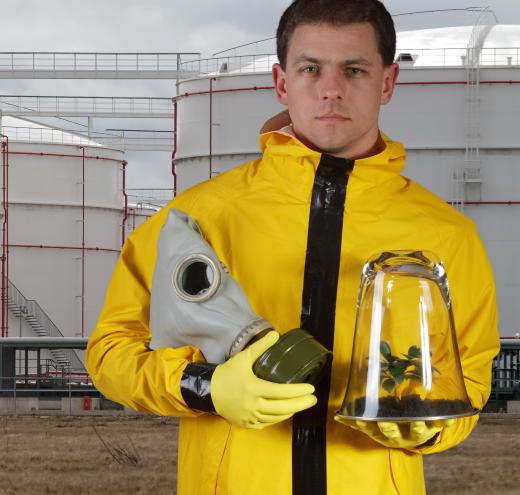What is Phosphorus?
 Mary McMahon
Mary McMahon
Phosphorus is a chemical element in the nitrogen group identified by the symbol P on the periodic table of elements. The nonmetallic element is extremely reactive and also highly toxic, although it is also an important trace mineral in most living organisms. There are numerous uses for phosphorus compounds, and most people interact with some form of the element every day. When someone strikes a match, fertilizes the garden, or uses most electronics, this element is involved.
The discovery of phosphorus is credited to Hennig Brandt, an alchemist who successfully isolated it from urine in the late 1660s. Brandt noted that his discovery possessed the curious property of glowing when it was exposed to air, and he named it after the Greek phosphoros, meaning “evening star.” The atomic number of phosphorus is 15, placing it among the lighter chemical elements, and it is rarely if ever found in a pure form.

Like other elements in the nitrogen group, a peculiarity of the structure of phosphorus causes it to make very strong bonds with other elements. In addition to making the element highly reactive, this also ensures that it appears in numerous compounds. One of the most important groups of phosphorus compounds is the phosphates. There are numerous examples of phosphates; most people are probably familiar with calcium phosphate, the mineral which composes the bulk of bone structure.

Along with several other elements, phosphorus exhibits allotropy, meaning that its pure form can appear in a number of ways in the same state. Carbon is another such element, appearing in the radically different but still pure forms of diamond and coal. Phosphorus has three allotropes; white, red, and black. White is the most toxic and reactive of the three, appearing as a waxy solid which ranges in color from white to yellow.

When exposed to air, white phosphorus will begin to burn, and the element also glows in the dark. Exposure to heat or light will turn it into red phosphorus, a much more stable allotrope which is used to make things like matches. If white phosphorus is heated under pressure, it turns into black phosphorus. All of these forms are pure, but they look and behave very differently.
In addition to matches, phosphorus is also used in incendiary devices, fertilizers, and fireworks. Some products may sport an anti-corrosive coating made of phosphorus, and the element is used as a dopant in electronics manufacturing as well. Since the element is toxic, pure forms should be handled with care, as should many of its compounds.
AS FEATURED ON:
AS FEATURED ON:













Discussion Comments
Thanks for this website! Really helped me with my homework! Could you possibly move your advertising so it doesn't get in the way of the actual article? It's slightly off-putting and frustrating! Thanks again.
I looked up this article because of a reference to bone phosphorus being added to naptha in a fantasy novel as an incendiary.
The reason I looked this up was because its listed as a content in my energy drink (20mg per serving). If it's toxic how can they add this compound to beverages?
super awesome website! thank you
amazing!
Thanks for helping with my home work. it was amazing and i finally understand the periodic table and the element of phosphorus!
awesome. this website is the best. i loved it. thanks to this web i got my answer to my questions!
I really have enjoyed every bit of information that you have on my questions. God bless all of you.
from fatfil57: if phosphor is toxic, why is it used in compact fluorescent lights?
I love this website! It is sooooo...interesting! Whenever I have a question I come here. Thank you for all that everyone has done to make this website a clean, safe, and enjoyable place for kids of all ages who have questions!
Post your comments